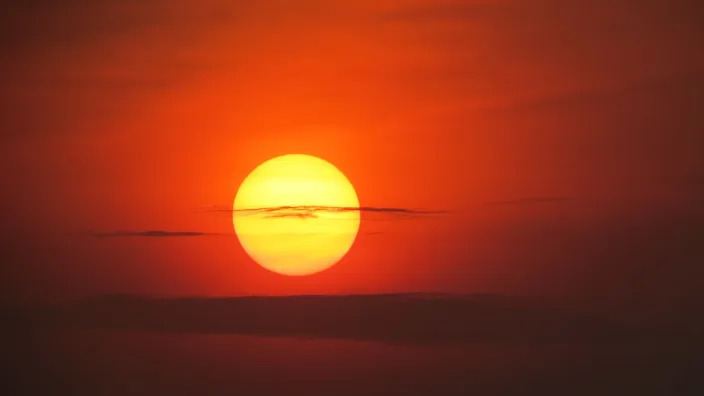Tony Ho Tran
Wed, February 8, 2023

Melissa van Niekerk via Unsplash
So things are pretty grim right now. Runaway greenhouse gas emissions have resulted in a rise in global temperatures—causing a domino effect of deadly weather crises and environmental disasters like flooding, droughts, and hurricanes. It’s gotten to the point where researchers are suggesting we take drastic measures in order to save humanity—even if that means pursuing the comic book villain-esque idea of literally blocking out the sun.
That’s the idea behind solar geoengineering, a catch all term that refers to the science and tech used to artificially change the climate by dimming the amount of sunlight that hits the Earth. There have been numerous proposals for this throughout the years including marine cloud brightening, which involves injecting aerosols into the stratosphere to reflect away sunlight. There are also proposals to take things even further by going beyond Earth’s atmosphere.
A study published on Feb. 8 in the journal PLOS Climate investigated the possibility of creating a solar shield by shooting dust into orbit between the sun and Earth. The dust would be placed at Lagrange points, or specific positions in space where gravity allows objects placed there to stay put. In doing so, the study’s authors say that the goal would be to provide up to six days worth of shade throughout the year—thereby resulting in a cooler climate.
Meet the People Who Want to Stop the Next Hurricane by Hacking the Ocean
“The goal of a geoengineer solution like ours, if necessary, would be to stave off increases in the weather fluctuations brought on by increasing climate change,” Benjamin Bromley, a theoretical astrophysicist at the University of Utah, told The Daily Beast in an email. He added that tools like the dust shield are important to have “in case we need more time for the main work” of reducing greenhouse gasses.
To create the dust shield, Bromley said that millions of tons of dust would need to be mined in order to be sent into a Lagrange point. They could also be dispersed in different areas in the space between the Earth and sun. Some dust shields could last just a few days before all that matter dissipates into parts unknown; while other dust shields could linger in orbit for much longer “depending on the dust properties and how the dust grains are launched.”
The researchers acknowledged that it’s not only more expensive to launch the dust from Earth, but it’s also difficult considering how far it would have to travel. To that end, the University of Utah team explored the possibility of using the moon as a launching point for the dust shield. Not only does the lunar surface provide a massive amount of dust that can be used, but the shield can be easily ejected from the moon towards the Lagrange point.
Blocking the Sun Is a Risky Gambit for Fighting Climate Change. It May Also Be Our Best Option.
“Major advantages of the moon include plentiful amounts of dust on its surface, and low force of gravity compared to Earth making it easier to launch the large amounts of dust required in this concept,” Bromley said.
While you might be worried that such a measure might inadvertently result in a permanent solar shield blocking sunlight from Earth, the study’s authors noted that it would naturally dissipate due to solar winds and radiation. Their investigation found that the dust would “not otherwise interact with our planet again.”
One area that the dust could potentially impact is space travel. Dust in the cosmos is famously one of the biggest challenges that spacecraft face when off Earth. While it might seem small and unassuming, in the vacuum of space, dust can turn into tiny bullets capable of shredding into a rocket or satellite. Millions of tons of dust floating in between the Earth and Sun could potentially pose a hazard if we were to travel that way.
However, Bromley said that their "simulations show that the dust would disperse into the broader solar system" without posing a threat to Earth.
Could Cooling the Planet Through Geoengineering Lead to More Disease Outbreaks?
Of course, there are plenty of critics that point out that research into solar geoengineering ultimately distracts from the real issues of climate change—namely greenhouse gas emissions. After all, why would we want to lower greenhouse gasses when we could simply yeet a bunch of dust into orbit to block the sun?
However, more and more people and institutions with deep pockets are beginning to ramp up investments in geoengineering tech. Solmar management projects are all the rage—from universitites, to gung-ho geoengineering startups, to even the White House. Dustin Moskowitz, one of Facebook’s co-founders who has a current estimated net worth of $14.1 billion, recently announced a massive $900,000 investment in a non-profit lab dedicated to solar geoengineering research.
That doesn’t change the fact that the most important and impactful thing we can do to reverse climate change is to lower our greenhouse gas emissions in order to stop the rise of global temperatures. That’s a lot easier said than done, especially with the immense power that the fossil fuel industry wields, but it’s really the best thing we can do.
So, as kooky and downright sci-fi as a solar shield sounds, it’s not all that out there. Unfortunately, with the way things are going, we might find ourselves in the situation where shooting dust at the sun isn’t just a radical solution—but also one of the only ones we have.
The Daily Beast.
No comments:
Post a Comment